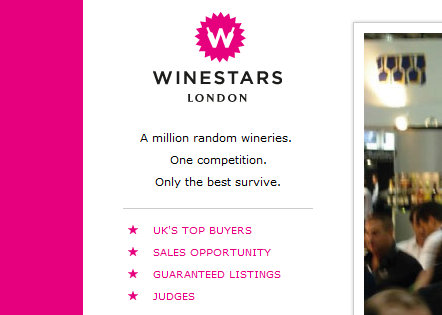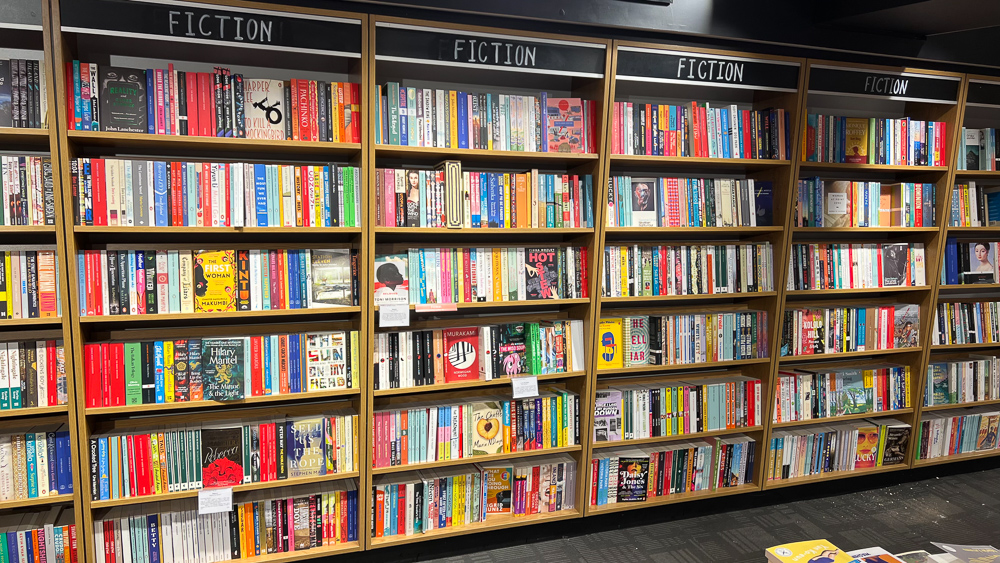Some of you may already have heard of Wine Stars, a new competition that will be launched at the London International Wine Fair later this month.
Anything that helps worthy producers of wine find the right channels to sell their wine has to be applauded. I hope it succeeds, and the caliber of the people involved gives it a very good chance of being a worthwhile venture.
I particularly like the way that the competition is setting out to encourage innovation, which is something the wine industry is short on. Look at the wine aisles: all the products look exactly the same (except to us, as category experts). They taste alarmingly similar, too.
But I admit to being slightly confused by what Wine Stars sets out to achieve when it promises ‘guaranteed listings’ and ‘huge sales opportunity’. Is it promising more than it can deliver, by failing to segment the wine market in the UK in an appropriate fashion?
The reason many producers struggle to sell their wine in the UK is because there is a mismatch between the scale of production and the shape of the retail market.
There are tens of thousands of wine producers across the world, and in particular in Europe, operating on a small scale – say under 25 hectares of vines. This is generally a good scale to make wine – family properties – for quality purposes. But it leads to an extremely fragmented, dispersed production base with insufficient scale to justify proper marketing/sales work and insufficient wine to supply large retailers.
The route to market in the UK is quite segmented. Most wine (around 75% by volume) is sold by supermarkets. Most of this is sold to people who aren’t terribly interested in wine. They are extremely price conscious, and the bulk of the wine sold will be at £5 or under. If you are a small producer, you’ll probably be too expensive to play here in addition to having insufficient volume.
Think about it: £5 retail price points can only be hit if the producer is getting just under 1 Euro ex cellars per bottle. If you are a small producer selling your wine for 4 Euros ex cellar (this is not terribly expensive), by the time your wine is on a supermarket shelf it will be at least £10, and is unlikely to sell much even if you get a listing. Remember, also that you’ll be taking a margin hit during promotions, and for some wines off-promotion sales are glacially slow.
So for these producers, supermarkets aren’t going to be a solution. And name a supermarket that is expanding its current producer base at the moment?
This means that a staggeringly large number of producers are facing a very congested route to market via independent wine shops and restaurants. These outlets already have their pick of a lot of very interesting wines, and many of them actively scout talent themselves. They also know what sells.
And then there are producers who sell for extremely high prices and have to allocate because of the demand. If you make exceptional wine and people realise this, then you can tear up the rule book. You can have horrible label design. You can be technical to the point of oscurity on your back label, and even do without a back label altogether. You can ignore social media, and have zero marketing budget. People will come to you. But it’s not a model I’d suggest for all wine producers.
I’m also confused by the criteria that Wine Stars will be using to judge wines.
Take two wines. One is a really nice but expensive Chablis made in small volumes. The other is a just-drinkable, very cheap Chablis. I know which I’d rather drink, but one is a really strong commercial proposition, while the other might not be. How would Wine Stars judge these wines?
Putting it another way, there’s a big market for very cheap wines, and a small one for more expensive ones. You just need to be realistic. Quality is not some universal property; it’s fitness for purpose. A neutral, drinkable supermarket Pinot Grigio at £3.99 is good quality: it is fit for purpose. It has a place on the shelf, and meets the expectations of those who buy it. Change it for a Pinot Grigio with lots of flavour and personality at £7.99 – a ‘better’ wine – and you’ll lose your customers. They simply won’t be interested: they never spend that much on a bottle and they’ll shop elsewhere.
Then there’s label design. I was speaking to a supermarket buyer the other day. He told me that they’d redesigned the labels on a white Bordeaux to make them look more modern and appealing, emphasizing the Sauvignon Blanc name. Sales went down. So they switched back to a very old fashioned and frankly dull label with a picture of a Chateau and a much more traditional feel. Sales went back up.
So, good luck, Wine Stars. We’ll be watching with interest.
12 Comments on Some thoughts on Wine Stars, a new competition



Regret to confirm your supermarket buyer story about consumers’expectations when it comes to label design especially for French wines. Been there a few times and found that labels with a traditional feel seem to be a prerequisite to achieve good sales. This has been known to lead to the French offer to be damned as not innovative enough by some of the industry leading lights.
Thanks for these thoughts, Jamie, which have helped clarify my own. I confess that when I read about the project, although I felt pleased on the one hand to see an original, exciting endeavour to get more interesting wines onto the UK shelves and to give producers a leg-up, on the other hand I felt worried. If I contacted a handful of the good, but obscure French producers I know (averaging not under 25 hectares but under 10ha of vines) and encouraged them, at seriously short notice, to work through the process of applying, what chance would they have to get through to the final rounds and what would happen next if they did? I don’t have the courage to encourage them, frankly.
Of course I wish Wine Stars luck, both the organisers and the producers with the courage to apply. And yes, I too will be watching with interest.
“Quality is not some universal property; it’s fitness for purpose. A neutral, drinkable supermarket Pinot Grigio at £3.99 is good quality: it is fit for purpose”
Hm – I think it’s fit for purpose, but to conflate that with quality is a bit dodgy to me. That would make Special Brew a quality beer.
Re-labelling and re-inventions of old classics is fraught with difficulty. We work with a Rioja that has a modern label and uses French oak. Distributors love the wine but criticise its lack of classic Rioja markers – American oak, oxidative character, old fashioned label. It’s what the market expects, and their clients complain Mess about with it at you peril!
Consumers build brands. For all its ‘reassuringly expensive’ positioning, Stella Artois is still just ‘a pint of wife beater please’.
Jamie, as someone who has been described – by Tim Atkin as I recall – as the Cassandra of wine, I have often expressed the view that the UK wine trade in particular is heading down a route with little joy for the small, quality-focused producer.
Yesterday, those gloomy views were supported by an Australian producer who had spent a couple of days looking at a range of UK retailers. He shook his head in dismay at the narrowness of the ranges he had seen – and the way they had shrunk over the last couple of decades. Where, he wanted to know, was the FUN? The excitement her remembered from the heyday of Oddbins, Wine Rack, Fullers, Bottoms Up – and the supermarkets?
WINESTARS is an effort to stem or at least slow that tide. The fact that we have got people like Waitrose, Mitchells & Butler, Laithwaites and SWIG on board hopefully means that some very prominent players are on our side.
I’d like to clarify what we are looking for: wines that a) taste really good; b) are appropriately priced; c) are appealingly packaged and d) come with some kind of story that will help encourage consumers to pick them up.
If we can get even a few producers to understand that a) and b) are prerequisites but not enough, we’ll have achieved something.
We’re NOT asking producers to ditch their traditional labels. Kevin Shaw of Stranger & Stranger, one of the judges, is a dab hand at designing labels that look as though they date from the 17th century, but the help to SELL the wine. To make it stand out on the shelf and attract consumer pick it up and try it.
I’m almost tempted to provide a realistic economic analysis from a producer’s point of view. But its too depressing.
I totally agree with Anne Burchett’s remarks on packaging, but there’s a good reason for this. In all the confusion of buying wine for most consumers, the driving emotion is fear of getting it wrong. They desperately want reassurance, so Chablis has to look like Chablis, Rioja like Rioja. They’re buying into the “brand” Chablis as much as the wine. Its only at a much higher experience level that consumers have enough knowledge to choose a wine based on the producer, the vintage, the winemaker, and pretty much ignore the specific design of the label. I can’t really see this changing quickly, most consumers are not our there looking to be “educated” about wine, they just want enough information to not make a wrong choice.
I do agree with Jamie. The preconception of Winestars is that there are thousands of people out there making brilliant wine who would be overjoyed to sell it at an “appropriate” price in Britain. They just hadn’t thought about it until this competition came along.
Winestars sounds lie a very interesting concept and good luck to all involved. Like everyone else I will be watching with keen interest.
WINE-STARS: OUR PURPOSE
We believe in empowering Wine Producers.
Human beings connect by telling stories. Wine Producers need an easier way of telling their stories.
We believe that wineries, small and large, need a platform that enables them to be seen and heard.
We believe the wine business needs innovation and to adopt more contemporary methods of doing business.
We believe the global wine-sourcing business model is changing, and we want to be part of that change.
We believe that wine producers in remote parts of the world need to have better access to markets.
We believe that wine trade buyers from all over the world need more dynamic ways of screening wineries and being introduced to them.
We believe that the global wine industry needs to embrace technology.
We believe that wine can be a vehicle for social change.
We believe the culture of the wine business needs to be more forward thinking and open.
We believe that the wine business should be a meritocracy.
We believe that a wine’s merit should be judged on more than simply what is inside the bottle.
In Vino Veritas…
Catherine
I loved most of the lines in your comment “WINE-STARS: OUR PURPOSE”
But I’ve got to fundamentally disagree on one…
“We believe that a wine’s merit should be judged on more than simply what is inside the bottle.”
In a wine competition, surely that’s the only thing a wine should be judged on?
Derek